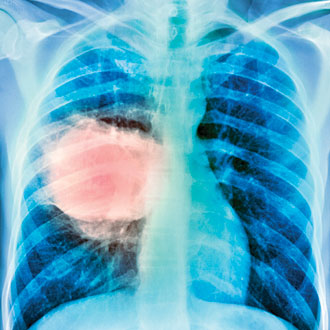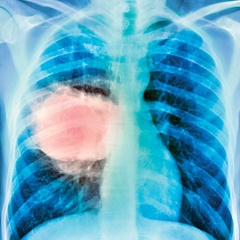NICE to lower the bar for cancer referral


GPs will soon be expected to refer far more patients for suspected cancer, with NICE guidelines detailing a raft of new symptoms that should now be investigated.
NICE billed the draft guideline – released in late November – as a deliberate attempt to offer ‘greater support to help GPs spot the warning signs of cancer’, lowering the risk threshold that is used to underpin recommendations from a positive predictive value of 5% to 3%.
As a result, there are 47 new recommendations, including urgent referral of people aged 40 to 55 years who have never smoked for suspected lung cancer if they have haemoptysis (with other symptoms like fatigue or weight loss), and anyone over 40 with unexplained weight loss and abdominal pain for suspected colorectal cancer.
There is also a new ‘very urgent’ referral recommendation – whereby the patient should be seen by a specialist within 48 hours – for children with symptoms suggestive of brain cancer, neuroblastoma or Wilm’s tumour.
Finally, there are recommendations that specify when GPs should be able to make a direct request for urgent tests including X-rays, endoscopy, CT or MRI scans and ultrasound within two weeks.
‘Overwhelming’
But there are concerns that the broadened guidance has also become too unwieldy for GPs to use in their day-to-day practice, is considerably more prescriptive about what investigations should be done and when and introduces a new layer of urgency for both investigations and referrals with the new 48-hour recommendations.
Dr John Hughes, former Manchester LMC secretary and a GP in the city, says this is off-putting for GPs and eats away at their professionalism.
He says: ‘The guidelines fail to recognise clinical skills and clinical experience will often be a diagnostic aid in deciding who has a problem with cancer.
‘It almost devalues the training of a clinician because if everyone with “x” symptoms should be referred, you may as well have a clerical person doing it.’
As well as detailing recommendations by cancer type, the new guidelines also now include a whole new section organised by symptoms – setting out which specific signs and symptoms are linked with certain cancers and what action to take.
This approach follows research on computer risk tools that aim to support GPs’ decisions in the large numbers of patients who present with non-specific, heterogeneous symptoms.
‘This new guidance is a welcome step in supporting GPs to do even better’
RCGP chair Dr Maureen Baker
One risk tool – the Cancer Decision Support tool being developed by the charity Macmillan with support from the Department of Health – has been under evaluation over the past two years and is now installed in 1,000 practices using EMIS, with a view to being rolled out widely in January.
NICE says the draft guideline has not covered such tools because ‘very little implementation or evaluation work’ is published on them, and their use in referral falls outside of the scope of the guideline.
However, some GPs say it is inappropriate to attempt instead to provide recommendations based around symptoms, arguing that the resulting list has not been properly evaluated and is too complicated for GPs to implement.
Professor Julia Hippisley-Cox, professor of clinical epidemiology and general practice at the University of Nottingham, whose QCancer risk tool underpins the Macmillan computer tool, says: ‘Essentially they have developed 150 or so new clinical risk rules which have not been validated or tested or peer reviewed in the usual way.
‘So we don’t know how many cancers would be missed using this approach. It’s also difficult to see how GPs might implement it.’
Dr Hughes says computer tools would be preferable, because they are less prescriptive than having a set of recommendations.
He says: ‘I think it would be better to have the decision-support tools as part of the diagnostic armamentarium, as an aid to professional judgment – they steer people more towards the potential for cancer, rather than being a rigid “you must refer” approach.’
Dr Dermot Ryan, a GPSI in endoscopy in Loughborough, says that this is a problem with NICE guidelines in general.
He says: ‘NICE looks at science, and 50% of medicine is really art. And actually that’s the most important part – you cannot have medicine without the so-called “gut instinct”.’
For some GPs, the length of the guideline will undermine its value.
Dr Andrew Mimnagh, a GP and clinical lead on urgent care at Sefton CCG, says the full draft is ‘overwhelming’.
He says: ‘My initial engagement was one of being slightly overwhelmed. I thought, this looks like a long job and one for another day – I have not actually opened it which says something about the volume.’
Struggling system
But if GPs do take time to read through the draft’s 400 pages, there are further concerns that, if implemented, the recommendations will increase the burden on the whole cancer treatment system.
NICE estimates the new recommendations will lead to 5-20% increases in referrals for suspected lower gastrointestinal (GI), urological, lung and children’s cancers, and a 2.5-5% increase in referrals for suspected cancer at unspecified sites.
For example, it anticipates referrals for suspected lower GI cancer could increase by 5-15% per year from the current annual figure of 192,000 in the UK.
Overall, it says the guidelines could cost as much as £36m per year for the additional outpatient referrals and associated diagnostic tests.
And there are signs the system is already struggling to manage increasing demands on cancer referral pathways.
A Monitor report earlier this year showed 62-day cancer treatment targets were being breached, while GP referrals were soaring.
Latest Government figures show that these treatment targets have now been missed for three consecutive quarters this year, with the proportion of patients treated on target slipping further each time.
And Pulse has learned that urgent cancer referrals are being ‘bounced back’ as a result of referral management, even in patients that later prove to have cancer.
Dr Andrew Green, chair of the GPC clinical and prescribing subcommittee, warns acute trusts will find it increasingly hard to meet targets, and there is a danger that ‘outcomes might worsen if waiting times for the most at-risk referrals increase because of the higher numbers of lower-risk patients’.
To ease some of the burden on secondary care, NICE recommends greater direct access to diagnostics, such as endoscopy in primary care for upper GI symptoms.
But Dr Mike Cohen, a GPSI in gastroenterology and member of the steering committee of the Primary Care Gastroenterology Society, who heads a primary care endoscopy unit in Bristol, says direct GP access will not help.
He says: ‘Capacity is a big issue for all endoscopy and there is a squeeze on it with the bowel screening programme, so units are working flat out.
‘I don’t think many patients go the clinic route for endoscopy. As I see it, they are going directly to endoscopy already, so I don’t see a reduction in clinic referrals. I think that is pie in the sky.’
The RCGP says much more investment is needed in general practice to provide practices with better direct access to diagnostics.
College chair Dr Maureen Baker says: ‘This new guidance is a welcome step in supporting GPs to do even better, but what is really needed is giving GPs easier access to diagnostics, such as CT and MRI scans and ultrasound.’
But there is a potential upside for GPs. The guidelines’ increased scope could help bring an end to the Catch-22 situation that GPs find themselves in with regard to cancer referrals.
On the one hand, GPs have been constrained by the existing guidelines, and the fear of provoking a terse letter from a consultant for an ‘inappropriate’ urgent referral.
On the other, they face increasing scrutiny over delayed or missed diagnoses, with reports of wide variations between practices in cancer referral rates.
The national press recently seized on practice data released on the NHS Choices to claim GPs were not referring people with cancer urgently.
And earlier this year, health secretary Jeremy Hunt announced plans to ‘name and shame’ GPs who fail to refer patients with cancer promptly, based on the variation in cancer diagnoses between practices, although he later clarified that he merely wanted better peer review of referrals.
Potential benefits
The witch-hunt has become so severe that GP experts were forced into publishing a piece in the BMJ to argue GPs’ case publicly, stating that patients presenting with various non-specific symptoms often need many visits before referral because GPs need to carry out necessary investigations.
Dr Green says the broader referral set out in the draft criteria should at least ease this pressure on GPs.
He says: ‘The guidance will inevitably result in increased referrals, and indeed that might not be a bad thing. For cancer mortality to improve, the relentless pressure on GPs to reduce referrals needs to end.’
NICE is keen to stress these remain draft guidelines. It says: ‘All relevant patient groups and organisations, including local [CCGs] and other GP-led bodies, are encouraged to register an interest in the guideline and submit comments via the NICE website during this consultation period.’
GPs can see some potential benefits too. Dr Cohen says: ‘The new guidelines are certainly clearer in giving GPs strong guidance that in some patients you are going to have to investigate a bit more.’
And Dr Richard Roope, cancer lead at the RCGP and Cancer Research UK, and a GP in Fareham, Hampshire, says that increasing pressure on the system could be what is needed to bring necessary investment.
Dr Roope says: ‘To a degree, it is one of those situations where until you have that pressure nothing is done about it – because if you are just about managing, what is the motivation to invest more and improve the service?
‘And hopefully, as these are only draft guidelines, we have time to address some of the infrastructure and personnel issues before they are introduced.’
‘We need to lower the threshold for referral’

It has been known for several years that we have poor outcomes in cancer in comparison to other developed countries.
We have seen improving UK cancer one-year survival rates (thought to be the best proxy measure for early detection) between 2004 and 2012. However, we still lag behind the European average.
To improve further we need to both lower the threshold for referral (the draft guidance suggests a referral risk threshold of 3%) and have better access to diagnostics – in terms of greater volumes and faster reporting times.
There are already a number of pilots under way looking at the effectiveness of direct GP access to diagnostics.
This will, of course, put more pressure on a system that is already stretched, but it will only be when demands significantly outstrip supply that the supply will be increased.
The UK currently has one of the lowest levels of scanning provision in developed countries (28th/30 for CT scanners per million population, and 3rd/29 for MRI scanners). We provide an amazing service on what we have – but with extra investment we could have even better outcomes.
The publication of these draft guidelines gives us time to address some of these important issues, and it is encouraging that our political and health leaders recognise the opportunities we have to make a real difference to our patients’ health.
Dr Richard Roope is the cancer lead for the RCGP and Cancer Research UK and a GP in Hampshire
Pulse October survey
Take our July 2025 survey to potentially win £1.000 worth of tokens

Visit Pulse Reference for details on 140 symptoms, including easily searchable symptoms and categories, offering you a free platform to check symptoms and receive potential diagnoses during consultations.










